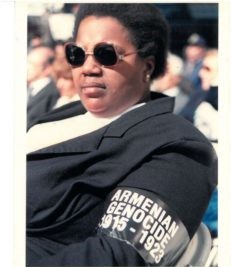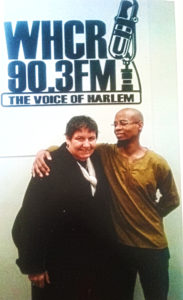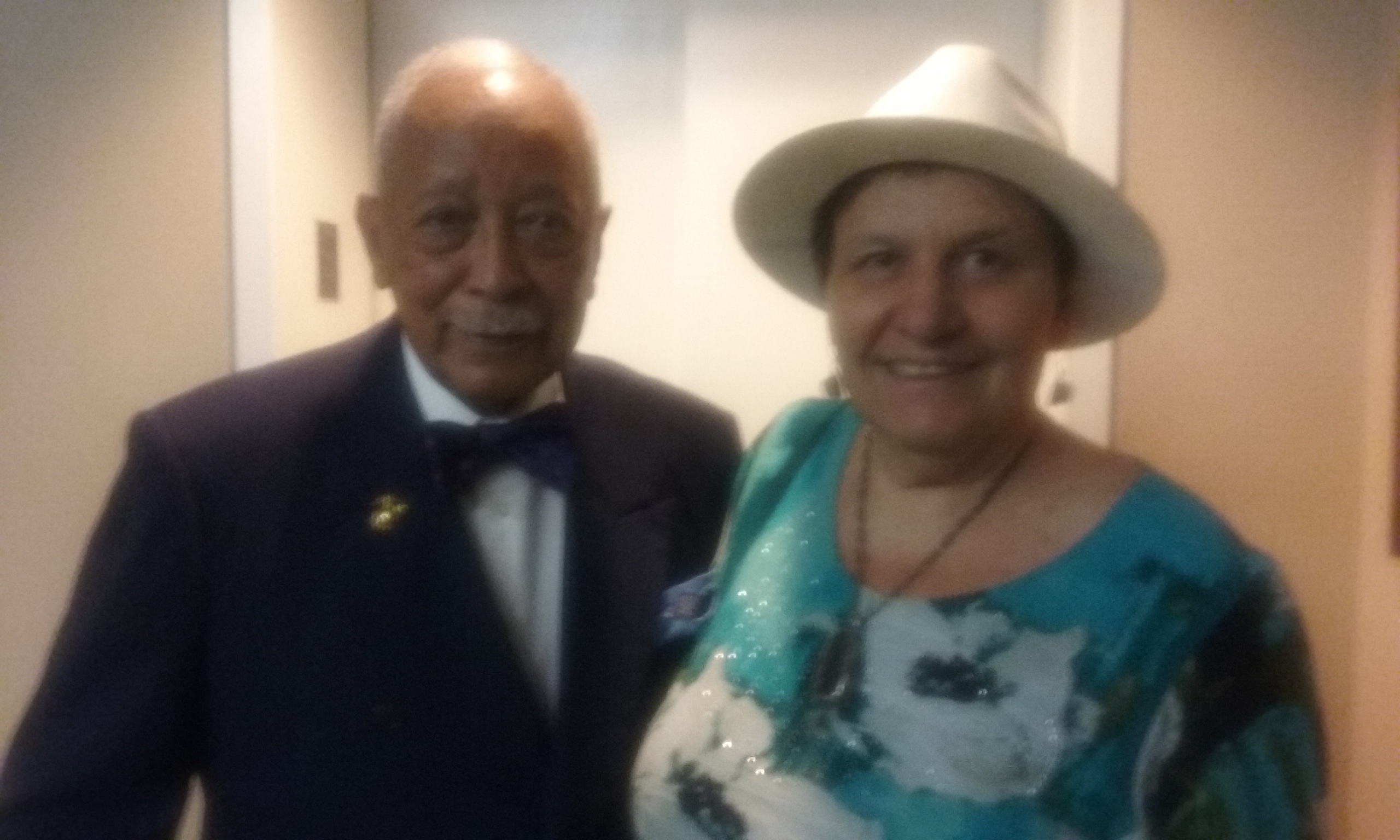I used to teach an anti-substance abuse program at an inner city school in New York back in 1990. One time, the program supervisor asked the teachers to share an example of their pain on the blackboard, as a way of motivating students to share their pain in return. I chose to write about the Armenian Genocide. Little did I know, one of my students was a relative of Congressman Stephen J. Solarz, who later became a major lobbyist for the Turkish Government in the United States. I guess that student told Solarz about what I had written, and the next day, I was called into my supervisor’s office and told that the Congressman had complained and I was not allowed to mentioned the Armenian Genocide in class again.

Later, in a gesture of solidarity, another teacher, an African-American named Joyce Miller, mentioned the Armenian Genocide in her classroom. That year, she was my guest at the April 24 luncheon at St. Vartan’s Cathedral commemorating the Armenian Genocide. New York City’s first African-American mayor, David Dinkins, was also in attendance. As he entered the hall, an Armenian woman at our table said, “I hope he doesn’t shake hands with me.” Insulted by this remark, my guest Ms. Miller told me she wanted to leave.
As we walked out, I wondered if this Armenian woman knew that the Kaffir members of a South African church sent collected funds amongst themselves and sent money in 1921 to the Near East Relief Fund to help hungry Armenians, victims of genocide? The minister of that church, D Mbengo-Nyangi, sent a photo and wrote a letter to the Armenian Genocide Museum in Yerevan as evidence. He wrote, “We can think of them with a thought as linking as charity—that thought is gratitude.” Would this woman shake hands with them?
Did she know that Nelson Mandela, the South African anti-apartheid freedom fighter, refused to accept the Ataturk International Peace Prize in 1992 because of Turkey’s history with human rights violations against its indigenous minorities? (Mandela was always known for fighting for justice, and his indigenous Xhosa name is Rolihlahla which means pulling the branch of the tree, colloquially defined as “troublemaker.”)

I learned a lot about South African history from Sduduzo Ka-Mbili, a Zulu-Bushman who founded the Juxtapower African dance company. Mbili is also an excellent sound engineer, and he diligently worked on helping produce my radio shows on the Armenian Genocide at WBAI for many years. Would this woman shake hands with him?

From Mbili, I learned that the indigenous Khoikhoi and San pastoralists of southwestern Africa were conquered by the Dutch in the 17th century, who then brought in their settlers to get land grants with the best water. The natives were forced out, massacred. Their lands were confiscated. There was forced labor and cultural suppression. When the British gained control of South Africa in 1806, they too continued the cycle of exploitation. They implemented cruel labor practices and discriminatory laws, like the 1913 Native Land Act, which preserved 87 percent of South Africa’s land for exclusive use by the white minority. Even today, conquerors kill and steal without ever being held accountable. When freedom fighters confront them in an effort to regain their ancient homeland, it is not uncommon for them to twist history and try to claim they are the real victims.
Mbili also told me about the erroneous ‘Boer Genocide,’ a misnomer by descendants of the Boer settlers occupying the stolen farms of South Africans, who were murdered by their ancestors. How can descendants of invaders gain consciousness that the stolen land they live on is not theirs? Will they ever peacefully restore it to the rightful indigenous caretakers, or must there always be indigenous armed liberation struggles?
Today, many dispossessed South Africans live in extreme poverty. Meanwhile, 80 percent of South African farmland is still occupied by white farmers. The European colonial model requires that conquered peoples pay for the land that was stolen from them. The African National Congress, Economic Freedom Fighters and other groups like the Landless People’s Movement in South Africa are all now (rightly) clamoring for land reform without having to pay compensation to the settlers who profited off past and present white control of South African land and resources. Unfortunately, efforts to take back this land have been blocked by threats of sanctions and calling in loans, which could lead to dire economic consequences for South Africa.
Diamond miners in South Africa also live in very poor conditions, while diamond companies continue to accumulate wealth. Stolen land and resources are open wounds that always fester. With this in mind, all those who have purchased De Beers diamond engagement rings should question how those diamonds could possibly be a symbol of love, when they cause so much suffering? I hope politically and spiritually conscious people around the world would consider returning these stolen resources. Diamonds could be a good place to start. How about donating them to South African organizations that help impoverished miners in South Africa?
As I accompanied Ms. Miller from the St. Vartan’s event, I wondered what Jesus would have said to the prejudiced Armenian woman who expressed dismay at the prospect of shaking Mayor Dinkins’ hand—the same mayor who sponsored Nelson Mandela’s victory tour to New York in 1990. I wondered if this Armenian woman realized we are all interconnected, as one humanity with different skin tones.

Dull Thud
An Armenian-South African solidarity poem
Birds chirping in vast maize fields. Dull thud, lid of dusty velvet ring box closing. Deep gasp seeing my sparkling dream come true diamond engagement ring. My parents beaming when I married the mining executive on his huge farm in his magnificent house.
Love evaporating like morning dew on violet leaves after twenty years of his desire for young African girls. So many, putting his thing where it didn’t belong like the drills of his toxic mines raping Mother Earth. He always felt the right to take what wasn’t his. So much poisonous sledge.
Dull thud of African bodies falling, blood spurting Boer bullets. African miners gasping for ownership of their ancestral land. Dustheat TB, ear shattering noise, hunger poverty searing. Who does my diamond really belong to?
I pass through the ghosts of my husband’s damage. Yet I am still here in our beautiful home, wondering. My daughter really loves her father, but she really doesn’t know who he is. She is in love and is dreaming of getting her own diamond engagement ring.
Outside, so many cacophonic noises. Why are the birds chirping at night? Wind bending over moving heat getting closer and closer, louder and louder. Dull thud boots of Africans coming to reclaim their birthright.


Anoush, thanks for your article and your activism.
Thanks for replying. I think there must be some people in the world who would want to help the South African miners and send back the Deep Beers diamonds.
thank you for your work, amazing piece.
In Trevor Noah’s “Born a Crime”, he mentions that it’s a common misconception that everything was fine and dandy in South Africa before apartheid. Nothing could be further from the truth. What apartheid did was institutionalize the status quo. In the process, South Africa became a near-fascist state. One of its most infamous foreign policy acts was its sending of troops – with the CIA’s backing – to the newly independent Angola to support ruthless thug Jonas Savimbi against the pro-democracy People’s Movement for Angola’s Liberation (MPLA). South Africa proceeded to wage what was basically their own version of the Vietnam War against Angola. Indeed, the US – having just suffered a miserable defeat in Southeast Asia – wanted to launch another war just to look tough. Cuba sent troops to support the MPLA. During the occupation, future lobbyist Jack Abramoff filmed “Red Scorpion” (made in cooperation with the apartheid government) in the occupied territory. South Africa eventually withdrew, leading to the full independence of both Angola and Namibia.
The part about members of the Independent Church sending aid to the Armenians reminds me of how the Cherokee Indians sent aid to the Irish during the potato famine.
God bless you. You are walking the walk
We are fortunate to have the Armenian Weekly deal with social justice issues.
Insane how they let this far left article be published on an ARMENIAN NEWS OUTLET. if Armenians were in South Africa we would too be slaughtered for being “white” we too would face murder and slaughter. This radical left wing articles need to stop.
Anoush jan, thank you for the courage to write on a sensitive topic and to call a spade a spade.
As a South African I don’t deny that we have an extremely high murder rate but your factually incorrect insinuation of a genocide is laughable. “White” people are not singled out for slaughter alas a bigger deal is made in the media and in the white community than about the murders of other ethnic groups. I am interested in knowing why the author callously used the term kaffir as it is a horrendously derogative term for black South Africans akin to calling black Americans niggers. Public use of the term has been banned and its use will result in possible incarceration.